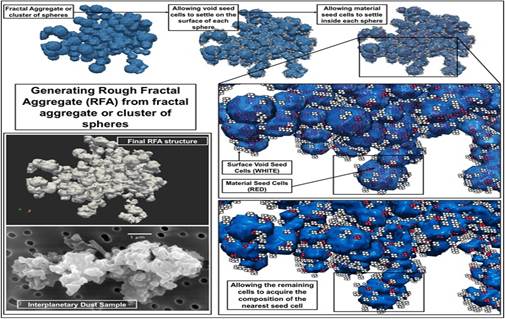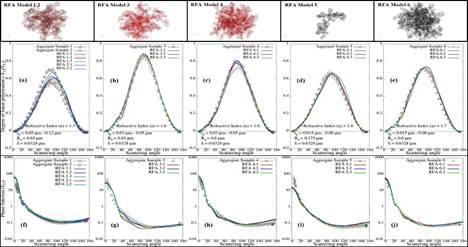Indian scientists develop ‘Model Cosmic Dust Particles’ to mimic the unusual polarisation of interstellar comet 2I/Borisov
Model Cosmic Dust Particles are tiny, solid particles that are found in space. They are made up of a variety of materials, including silicates, carbon, and ice. Cosmic dust particles are important because they play a role in the formation of stars and planets. They also help to scatter light, which makes the night sky appear to be filled with stars.
In recent years, scientists have developed a number of models of cosmic dust particles. These models are used to study the properties of cosmic dust particles and to understand their role in the formation of stars and planets.
One of the most recent models of cosmic dust particles was developed by scientists at the Indian Institute of Astrophysics (IIA) in Bangalore, India. The model, which is called REST (Rough Ellipsoid Structure Tools), is able to create visually realistic cosmic dust particles.
The REST model is based on the idea that cosmic dust particles are formed by the coagulation of smaller particles. The model takes into account the effects of surface roughness and irregularities on the scattering of light by cosmic dust particles.
The REST model has been used to study the polarimetric properties of comets. Comets are icy bodies that orbit the Sun. They are made up of a mixture of dust and gas. The dust in comets is thought to be made up of cosmic dust particles.
The REST model has been able to reproduce the polarimetric properties of comets, including the steep polarimetric slope that is observed in some comets. This suggests that the REST model is a realistic model of cosmic dust particles.
The REST (Rough Ellipsoid Structure Tools) model is a significant advance in the study of cosmic dust particles. It is the first model that is able to create visually realistic cosmic dust particles. The model is also able to reproduce the polarimetric properties of comets. This suggests that the REST model is a valuable tool for studying the properties of cosmic dust particles and their role in the formation of stars and planets.

Figure-1: Algorithm for generating visually realistic Rough Fractal Aggregate (RFA)
Innovation
The REST model is an innovative approach to modeling cosmic dust particles. The model is based on the idea that cosmic dust particles are formed by the coagulation of smaller particles. The model takes into account the effects of surface roughness and irregularities on the scattering of light by cosmic dust particles.
The REST model has been used to study the polarimetric properties of comets. Comets are icy bodies that orbit the Sun. They are made up of a mixture of dust and gas. The dust in comets is thought to be made up of cosmic dust particles.
The REST model has been able to reproduce the polarimetric properties of comets, including the steep polarimetric slope that is observed in some comets. This suggests that the REST model is a realistic model of cosmic dust particles.

Figure-2: Variation of the degree of linear polarization -S12/S11 (a-e) and phase function S11 (f-j) with scattering angle for RFA model structures (1-6) (Solid lines) compared with the experimental results for Aggregate Samples (1-6) (hollow squares and triangles) from the Granada Amsterdam Light Scattering Database
Research
The REST model has been used to study the properties of cosmic dust particles. The model has been used to study the scattering of light by cosmic dust particles. The model has also been used to study the polarimetric properties of comets.
The REST model is a valuable tool for studying the properties of cosmic dust particles. The model is able to reproduce the scattering of light by cosmic dust particles and the polarimetric properties of comets. This suggests that the REST model is a realistic model of cosmic dust particles.
Role of Scientists
The REST model was developed by scientists at the Indian Institute of Astrophysics (IIA) in Bangalore, India.
The scientists who developed the REST model are Dr. Prithish Halder and Prof. Sujan Sengupta.
Dr. Prithish Halder is a postdoctoral fellow at the IIA. He is interested in the study of cosmic dust particles and their role in the formation of stars and planets.
Prof. Sujan Sengupta is a scientist at the IIA. He is interested in the study of light scattering by cosmic dust particles.
The scientists who developed the REST model are experts in the study of cosmic dust particles. They have a deep understanding of the physics of light scattering by cosmic dust particles. This expertise was essential for the development of the REST model.

Figure-3: Best fit model results using Model𝑅 for the interstellar comet 2I/Borisov with the observations (red filled circles) at wavelengths 𝜆 = 0.557𝜇m (𝑉𝑓 filter), 0.655𝜇m (𝑅𝑓 filter) and 0.768𝜇m (𝐼𝑓 filter) and compared with the polarimetric observations of the comet C/1995 O1 (Hale-Bopp) (blue filled circles) at 𝜆 = 0.4845𝜇m, 0.620𝜇m and 0.730𝜇m for Carbon:Silicate = 50:50 (n=2.6) (a-c).
Significance
The REST model is a significant advance in the study of cosmic dust particles. The model is the first model that is able to create visually realistic cosmic dust particles. The model is also able to reproduce the polarimetric properties of comets.
This suggests that the REST model is a valuable tool for studying the properties of cosmic dust particles and their role in the formation of stars and planets.
The REST model is a significant contribution to the field of astronomy. The model is a valuable tool for studying the properties of cosmic dust particles. The model is also a valuable tool for understanding the formation of stars and planets.
[Sources: 1. Press Information Bureau (pib.gov.in) I 2. A Comprehensive Model of Morphologically Realistic Cosmic Dust Particles: An Application to Mimic the Unusual Polarization Properties of the Interstellar Comet 2I/Borisov (iop.org) ]










